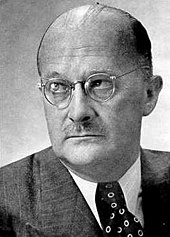Adolf Windaus
Adolf Otto Reinhold Windaus (born December 25, 1876 in Berlin , † June 9, 1959 in Göttingen ) was a German chemist and biochemist . In 1928 he was awarded the Nobel Prize in Chemistry .
Life and accomplishments
Adolf Windaus was the son of a textile manufacturer. After completing his schooling at the French grammar school in Berlin, he first studied medicine in Berlin from 1895 , but after completing the Physikum in 1897 he turned to chemistry in Freiburg and received his doctorate in 1899 with Heinrich Kiliani in Freiburg with his dissertation on new contributions to the knowledge of digitized substances. He then went back to Berlin to work for Emil Fischer . In 1901 he moved again to Freiburg, where he in 1903 with a thesis on cholesterol habilitated .
He was a private lecturer and from 1906 adjunct professor in Freiburg until 1913, then full professor in Innsbruck , where he held the chair for applied medicinal chemistry until 1915. He then went to Göttingen as the successor to Otto Wallach , where he held the chair of chemistry until his retirement in 1944.
His habilitation thesis, submitted in Freiburg in 1903, was already entitled About Cholesterol . His further research was also geared towards the chemistry of steroids .
In 1919 Adolf Windaus succeeded in demonstrating the relationship between cholesterol and bile acids. He also clarified the chemical structure of various vitamins of the B complex and the D group and confirmed his results through their synthesis. The vitamin D, synthesized photochemically from a substance previously isolated from ergot, according to his method (1927) was marketed under the brand name Vigantol by the pharmaceutical companies E. Merck ( Darmstadt ) and Bayer ( Leverkusen ).
His grave is in the Göttingen city cemetery , where other Nobel Prize winners are buried.
Honors
Windaus received the Nobel Prize for Chemistry in 1928 for his services to research into the structure of sterols and their connection with the antirachitic D vitamins. The structural formula of cholesterol proposed in his Nobel lecture was, however, revised in 1932 by Windaus himself based on the research results of John Desmond Bernal (1901–1971, University of Cambridge / Great Britain). In 1941 he was awarded the Goethe Medal for Art and Science by Adolf Hitler .
Windaus was a member of the Academy of Sciences in Göttingen and holder of the order Pour le Merite for the sciences and the arts . As further honors he received a. a. the Adolf von Baeyer commemorative coin, the Louis Pasteur medal and numerous honorary doctorates . From 1922 he was a member of the German Academy of Sciences Leopoldina and from 1927 a corresponding member of the Bavarian Academy of Sciences . In 1936 he was accepted as an extraordinary member of the Prussian Academy of Sciences . In 1943 he became an honorary member of the Leopoldina.
The Adolf Windaus Medal of the University of Göttingen is named in his honor.
In 1951 he received the Great Cross of Merit of the Federal Republic of Germany from the hand of Federal President Theodor Heuss .
In his address on his 65th birthday, Wilhelm Biltz said :
- When I imagine a monument that a grateful humanity will one day erect in Windau, crowds of children crowd around its figure, who owe it health and healing.
literature
- Karl Dimroth: The Portrait: Adolf Windaus 1876-1959 . In: Chemistry in Our Time . tape 10 , no. 6 , 1976, ISSN 0009-2851 , pp. 175-179 , doi : 10.1002 / ciuz.19760100603 .
- J. Haas: Vigantol - Adolf Windaus and the history of vitamin D. Scientific publishing company, Stuttgart 2007, ISBN 978-3-8047-2223-1 .
- Axel W. Bauer : Windaus, Adolf. In: Werner E. Gerabek , Bernhard D. Haage, Gundolf Keil , Wolfgang Wegner (eds.): Enzyklopädie Medizingeschichte. Walter de Gruyter, Berlin / New York 2005, ISBN 3-11-015714-4 , p. 1499 f.
Web links
- Literature by and about Adolf Windaus in the catalog of the German National Library
- The Göttingen Nobel Prize miracle
- Information from the Nobel Foundation on the award ceremony in 1928 to Adolf Otto Reinhold Windaus
- Biography of Adolf Windaus
- University of Freiburg: Windaus
Individual evidence
- ↑ Axel W. Bauer: Adolf Windaus , in: Wolfgang U. Eckart and Christoph Gradmann (eds.): Ärztelexikon. From antiquity to the present , 3rd edition 2006 Springer Verlag Heidelberg, Berlin, New York p. 347. Medical dictionary 2006 . doi : 10.1007 / 978-3-540-29585-3 .
- ^ Otto Westphal , Theodor Wieland , Heinrich Huebschmann: life regulator. Of hormones, vitamins, ferments and other active ingredients. Societäts-Verlag, Frankfurt am Main 1941 (= Frankfurter Bücher. Research and Life. Volume 1), p. 53 f.
- ↑ Adolf Winau: Antirachitic vitamin from irradiated ergosterol. In: Hoppe-Seyler's journal for physiological chemistry. Volume 203, 1931, pp. 70-75.
- ↑ Albert Gossauer: Structure and reactivity of biomolecules. Verlag Helvetica Chimica Acta, Zurich, 2006, ISBN 3-906390-29-2 , p. 220.
- ^ Member entry of Adolf Windaus at the German Academy of Natural Scientists Leopoldina , accessed on August 8, 2012.
- ^ Members of the previous academies. Adolf Windaus. Berlin-Brandenburg Academy of Sciences , accessed on June 28, 2015 .
- ↑ Announcement of awards of the Order of Merit of the Federal Republic of Germany. In: Federal Gazette . Vol. 3, No. 250, December 29, 1951.
| personal data | |
|---|---|
| SURNAME | Windaus, Adolf |
| ALTERNATIVE NAMES | Windaus, Adolf Otto Reinhold |
| BRIEF DESCRIPTION | German chemist, Nobel Prize in Chemistry 1928 |
| DATE OF BIRTH | December 25, 1876 |
| PLACE OF BIRTH | Berlin |
| DATE OF DEATH | June 9, 1959 |
| Place of death | Goettingen |

